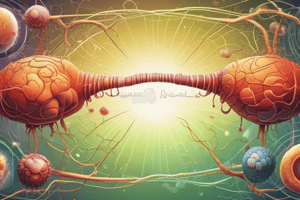Podcast
Questions and Answers
Which macronutrient is primarily used for fuel during high-intensity exercise lasting up to 2 hours?
Which macronutrient is primarily used for fuel during high-intensity exercise lasting up to 2 hours?
- Proteins
- Vitamins
- Carbohydrates (correct)
- Fats
Anorexia Nervosa is characterized by binge eating and purging.
Anorexia Nervosa is characterized by binge eating and purging.
False (B)
What is the immediate energy source for muscle use?
What is the immediate energy source for muscle use?
ATP
1 pound of fat is equivalent to _______ kcal.
1 pound of fat is equivalent to _______ kcal.
Match the following eating disorders with their characteristics:
Match the following eating disorders with their characteristics:
What is the primary function of ATP in metabolism?
What is the primary function of ATP in metabolism?
Anaerobic respiration occurs with the presence of oxygen.
Anaerobic respiration occurs with the presence of oxygen.
What is the end product of glycolysis?
What is the end product of glycolysis?
During low carbohydrate diets, excess Acetyl-CoA forms __________.
During low carbohydrate diets, excess Acetyl-CoA forms __________.
Match the following metabolic processes with their functions:
Match the following metabolic processes with their functions:
What percentage of total energy expenditure does Basal Metabolic Rate (BMR) account for?
What percentage of total energy expenditure does Basal Metabolic Rate (BMR) account for?
Women tend to have a higher alcohol tolerance than men due to higher levels of alcohol dehydrogenase (ADH).
Women tend to have a higher alcohol tolerance than men due to higher levels of alcohol dehydrogenase (ADH).
What is produced during lipolysis?
What is produced during lipolysis?
Flashcards
Set-Point Theory
Set-Point Theory
A biologically determined weight range that the body tries to maintain.
Gastroplasty
Gastroplasty
A surgical procedure to reduce stomach size, aiming for weight loss. It involves various techniques like banding, bypass, and sleeve.
Anorexia Nervosa
Anorexia Nervosa
An eating disorder characterized by self-starvation and extreme fear of weight gain.
Bulimia Nervosa
Bulimia Nervosa
Signup and view all the flashcards
ATP
ATP
Signup and view all the flashcards
Metabolism
Metabolism
Signup and view all the flashcards
Anabolic Processes
Anabolic Processes
Signup and view all the flashcards
Catabolic Processes
Catabolic Processes
Signup and view all the flashcards
Acetyl-CoA
Acetyl-CoA
Signup and view all the flashcards
Aerobic Respiration
Aerobic Respiration
Signup and view all the flashcards
Anaerobic Respiration
Anaerobic Respiration
Signup and view all the flashcards
Glycolysis
Glycolysis
Signup and view all the flashcards
Study Notes
Chapter 9: Metabolism
- Metabolism is the totality of chemical reactions in the body, crucial for maintaining life.
- Anabolic reactions build complex molecules, such as glucose to glycogen.
- Catabolic reactions break down complex molecules, like glycogen to glucose to create carbon dioxide, water, and ATP.
- ATP is the primary energy currency, storing and releasing energy as needed.
- All macronutrients must become Acetyl-CoA before entering cellular respiration.
- Aerobic respiration utilizes oxygen.
- Anaerobic respiration doesn't require oxygen.
- Cellular respiration releases energy, CO2, and water by oxidizing food molecules.
- LEO (Lose Electron Oxidation) and GER (Gain Electron Reduction) denote electron transfer.
- Carbohydrate metabolism includes glycolysis (2 ATP), the transition reaction, the citric acid cycle (2 ATP), and the electron transport chain (30-32 ATP).
- Anaerobic respiration converts pyruvate to lactate, important during intense exercise.
- Fat metabolism (lipolysis) involves fatty acid breakdown (β-oxidation) to Acetyl-CoA.
- Fat provides more energy (9 kcal/g) than carbohydrates (4 kcal/g).
- Efficient fat metabolism needs oxaloacetate from glucose.
- Ketosis occurs when carbohydrate intake is low. Low oxaloacetate causes Acetyl-CoA to form ketones. Ketosis occurs in type 1 diabetes due to no insulin.
- Protein metabolism happens mainly in the liver, creating glucose from glucogenic amino acids. Nitrogen is removed and eliminated as urea in urine.
- Alcohol metabolism converts alcohol to Acetyl-CoA through the alcohol dehydrogenase pathway, primarily used for fat synthesis. Women have slower alcohol metabolism.
- Fasting involves breaking down glycogen and fat, generating ketones.
- Feasting involves synthesizing glycogen and protein, forming urea.
Chapter 10: Energy Balance
- Bomb calorimeter measures the energy content of food.
- Basal Metabolic Rate (BMR) represents the minimal energy for vital functions (60-70% of total expenditure).
- Physical activity increases BMR by 25-40%.
- The thermic effect of food accounts for 5-10% of energy consumption.
- Body fat assessment methods include underwater weighing, skinfold thickness, and bioelectrical impedance.
- Genetics plays a significant role (40-70%) in body weight.
- Set-point theory suggests a genetically predetermined weight and fat content.
- Weight management considers that 1 lb of fat equates to 3,500 kcal.
- Gastroplasty involves surgical procedures like gastric banding, bypass, and sleeve gastrectomy for weight loss.
- Eating disorders:
- Anorexia nervosa is characterized by self-starvation, distorted body image, and has consequences such as low bone mass, muscle wasting, anemia, and lanugo.
- Bulimia nervosa involves binge eating and purging. Consequences include electrolyte imbalances, dental decay, and ulcers.
- Nutrition therapy focuses on regular eating patterns, food records, behavior modification, and avoidance of trigger foods.
- Leptin is a hormone signaling satiety.
Chapter 11: Fitness and Energy
- Fitness program characteristics depend on mode (type of exercise), duration, frequency, intensity, and Rate of Perceived Exertion (RPE) scale.
- Immediate energy source for muscle use is ATP.
- Phosphocreatine provides high-energy for about 10 seconds.
- Carbohydrates are the primary energy source for short to medium-term, high-intensity exercise. Carbohydrate breakdown can occur aerobically (28-30 ATP) or anaerobically (pyruvate to lactate; 2 ATP). Muscle glycogen is used for up to two hours of activity.
- Fat is the primary energy source for long, low-intensity exercise. Fat provides 9 kcal/g but is slower to metabolize than carbohydrates.
- Protein is a minor fuel source; essential branched-chain amino acids can be converted to glucose via gluconeogenesis.
Studying That Suits You
Use AI to generate personalized quizzes and flashcards to suit your learning preferences.




